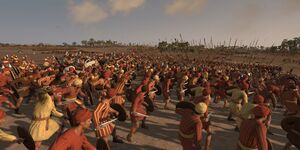Autumn Flag Rebellions
The Autumn Flag Rebellions, also translated as the Autumn Banner Rebellions and recognized as the Autumn Scarf Rebellions, the Autumn Turban Rebellions, and the Autumn Flag Disturbance, were a series of uprisings against Symmerian rule in Quenmin, Tamau, Aichi and Nagarcam that lasted from 1063 to 1077. The rebellions received their names by historians for the prolieration of flags and scarves with colors associated with autumn—red, yellow, and brown; this set of colors was chosen among leaders as mutual symbols of resistance and a combined sign for the downfall of the status quo. The collective violent unrest is the last of the anti-Symmerian rebellions to occur within Greater Quenmin.
After the defeat of Seleucus of Ioklos in the eponymous civil war, Symmerian governance was restored with Clytomedes appointed satrap. However, stricter laws, harsh punishments, and heavy taxes imposed by Clytomedes at the behest of Symmerian king Arcidamus as a punitive consequence instilled contempt among the province's citizenry. Furthermore, famines and natural disasters introduced strains on the Symmerian Quenminese government, which observed the growth of starvation and poverty. In 1061, these disasters played a role in influencing the visions of Haimeist priest Văn Ngọc Quyết, who interpreted the violent acceleration of autumn into spring with a red, yellow and brown sky in his dream coupled with the disasters as a sign given by Mộng Diễm of the coming of a apocalyptic turbulence paving new governance. After garnering a significant following, Quyết ordered his followers to travel to areas affected by poverty and natural disasters, and help the afflicted and propagate their teachings to them. This gained the attention of important figures, namely Generals Lưu Ðình Dương, Tôn Kiến Bình and Pheng Thaiv Tsaab; Hmong chiefs Keej Chao Cha and Fong Dej Gao; and Olympio-Haimeist priests Heracleides Philkuenaeus, Antialcidas of Calat, and Agathonice the Haimeist. Later in 1063, uprisings were instigated from towns and countrysides stretching from northern to southern Quenmin.
As the initial Rebellions gained more traction from 1063 to 1065, followers from Tamau, present-day Aichi, and Nagarcam surged the ranks, with urges proclaimed by future leaders Ratsadathirat I, Linn Thura and Jaya Bhasadharmavarman I. By 1068, the Autumn Flags gained increasing momentum and more districts fell within their influence. However, a counteroffensive campaign from northern Quenmin and Tamau led by Menexinos and Kerkyon alongside their Quenminese and Nagarcamese collaborators Huỳnh Cao Thọ and Adratipin respectively stalled them and began to push back the rebels until a stalemate was reached in 1071. Infighting among the Quenminese Autumn Flags occurred within 1070 to 1071 time after the death of Văn Ngọc Quyết, which resulted in a power struggle between the Biểc, Hmong and Hellene leaderships. In the autumn of 1071, future Quenminese emperor Hoạn Quốc Tổ put an end to the fractures and reunified the Movement, which resulted in the deaths of Lưu Ðình Dương and Eucratides of Doracuse. Hoạn Quốc Tổ then reoganized the Quenminese Autumn Flags and inflicted a decisive defeat against the Symmerians at the Battle of Ban Bat in August 1072. The Autumn Flags continued to achieve victories, particularly at Nghĩa Hưng, Chiapratheth, Bawlamyaing, and Ambegiri. In 1076, the Autumn Flags achieved a decisive victory at the Battle of Vung Xuyên, considered by many military historians to be Hoạn Quốc Tổ's masterpiece in that the outcome of the battle guaranteed the surrender of the Symmerian government in Spring 1077 at the Battle of Lùng Khấu Nhin. Remaining Symmerian holdouts in Aichi and Nagarcam were suppressed in Summer 1077.
The victory attained by the Autumn Flags held significant impact in both Greater Quenmin and the Symmerian Empire. Within the former, independent nations emerged with their leaders ascending as kings or emperors, namely the Early Hoạn dynasty, Nagarcam, the Paphan Kingdom and the Nambyan Republic. For the latter, the outcome of the bloody conflict observed the permanent dissolution of Symmerian governance over Greater Quenmin and inspired rebellions in adjacent provinces; moreover, it exacerbated the already weakening Symmerian hold on southeast Siduri. Consequently, the Autumn Flag Rebellions remain a noteworthy event in the history of East Siduri, and remains a symbol of nationalism and unity among nations and ethnicities in Greater Quenmin.
Background
The rebellions
Initial traction
Symmerian offensive and stalemate
Infighting in the Quenminese Autumn Flag factions
Autumn Flag countermove and offensive
Symmerian surrender and suppression of remaining holdouts
Aftermath and impact
Legacy
In film and televsion, three television series were released in 1985, 2000, and 2014. The 2000 version remains the most historically accurate.
Quocvangist propaganda
During the Siduri War, the Quocvangist government depicted events and leaders to disseminate and instill nationalism in response to the Inner Sphere invasion, further enhancing the significance of the Rebellions.
